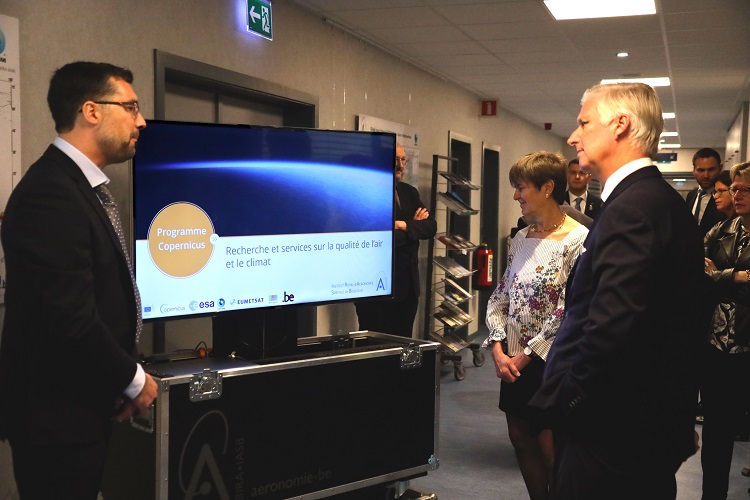On Wednesday January 31, His Majesty the King Philippe of Belgium arrived at the door of the Royal Belgian Institute for Space Aeronomy (BIRA-IASB). His visit had been announced a while before, so we were prepared! King Philippe was received by the directors of the three institutes of the Space Pole site, including our own director Martine De Mazière. This was followed by a few explanations and presentations of the researchers themselves, including two of our Institute: Nicolas Theys (scientist in the “Air Quality” team) and Emmanuel Dekemper (scientist in the ALTIUS space mission team).
A long anticipated arrival
After almost three months of preparations, the early morning hours was tense anticipation for the arrival of our monarch. In the recently released documentary "Filip, een jaar met de koning der Belgen"/"Philippe, une année avec le roi des belges", the King already expressed his love for space missions and space science, and his pride for Belgian contributions in this field. It was therefore a real pleasure to present a glimpse of our research activities to Him.
The science speaks for itself

Credit: Pierre Gerard (BIRA-IASB)
During the visit, the three different federal scientific institutes located at the Space Pole in Uccle (The Royal Observatory of Belgium, the Royal Meteorological Institute and ourselves, the Royal Belgian Institute for Space Aeronomy) were represented by their directors, who welcomed King Philippe in the building of the Royal Belgian Institute for Space Aeronomy.
A handful of the hundreds of researchers and engineers shared some of the key fields that our country is involved in. For BIRA-IASB, these were terrestrial research in climate (and dangers of climate change), air quality (and dangers to public health and ecosystems) and the ozone layer (and the “ozone hole”, which will take several more decades to restore).

Credit: Pierre Gerard (BIRA-IASB)
BIRA-IASB scientist Nicolas Theys exchanged with the King about our contributions to the European Copernicus programme in terms of climate and air quality data, mainly with the Sentinel-5P\TROPOMI satellite data, but also thanks to the use of ground station networks and airplanes to allow for rigorous data validation and local measurements.
BIRA-IASB scientist Emmanuel Dekemper talked with the King about the upcoming space mission, ALTIUS, intiated at our institute, and now the next ESA mission for ozone monitoring. He explained the need for pursuing the satellite observations of the ozone layer, which is still suffering from decades of CFCs emissions, but also from global warming. The King was shown how the “ozone hole” still forms every year above Antarctica, although no longer drawing much public interest. The involvement of the Belgian space sector in ALTIUS was also tackled. Two scale models of the ALTIUS satellite were prominently displayed during the visit, and Emmanuel also invited the King to the ALTIUS satellite launch, set to take place in 2026.
At the end of the visit, the King was enthusiastically waved off by scientists, engineers and support staff from the entire Space Pole.

Credit: Pierre Gerard (BIRA-IASB)
Credit: Pierre Gerard (BIRA-IASB)
Credit: Pierre Gerard (BIRA-IASB)

